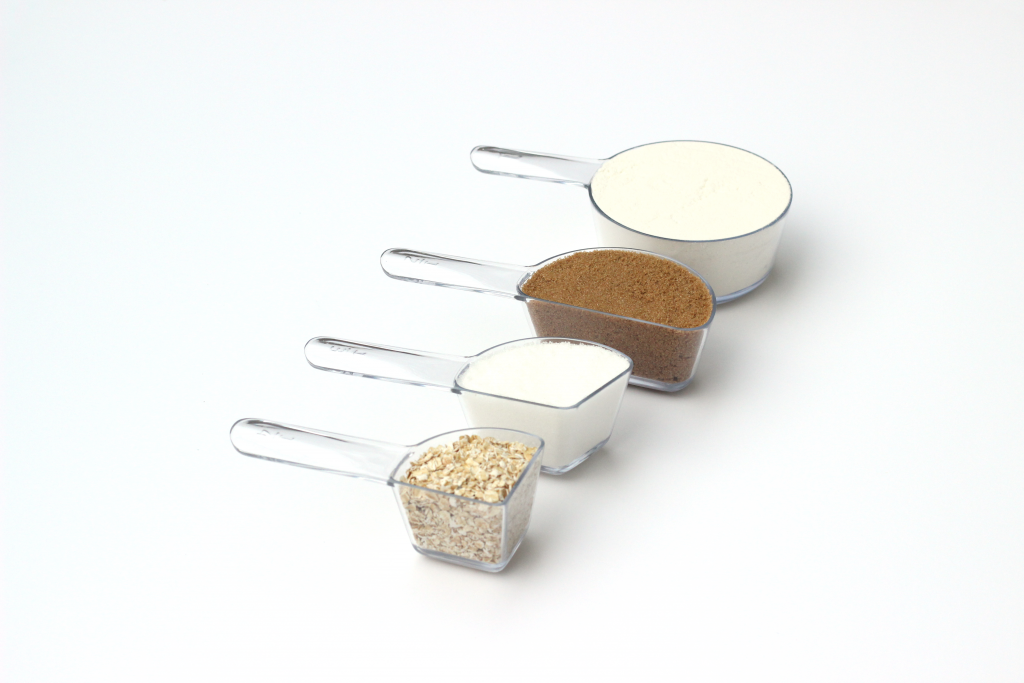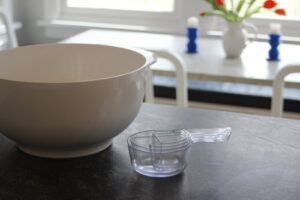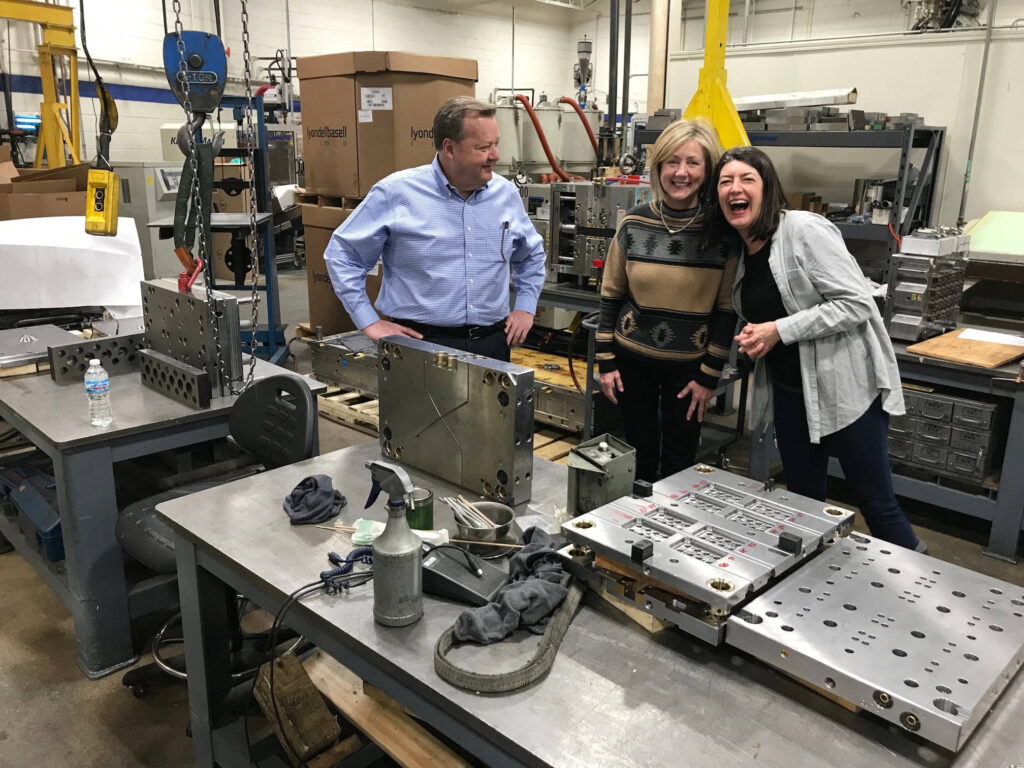
The cups are the brainchild of Chicago-based industrial designer Pam Daniels.
Most of us of take for granted the many tangible objects in our daily lives. But even the simplest of items are the result of a design process that entails hundreds of decisions on how a product will improve our lives.

The people who begin with an idea or concept and ultimately embark on the prolonged journey of producing an actual object are known as industrial designers. The goal of most industrial designers is to take an idea and turn it into a manufactured product.
Pam Daniels is a Chicago-based industrial designer and founding partner and owner of Welcome Industries, a design practice dedicated to working closely with American manufacturers.
Along with co-founding partner Brandon Williams, Daniels recently brought to market her most successful houseware design yet – Visual Measuring Cups. This kitchen product takes the guesswork out of trying to “eyeball” a specified amount of an ingredient needed for a successful recipe.
The Visual Measuring Cups are four pie-slice shaped utensils that are easily distinguishable and nest tightly together for easy storage in a standard kitchen drawer. Whether you need to measure a full cup, ½ cup, 1/3 cup or ¼ cup, Daniels has created the most efficient way of measuring that is simple, exact and, most importantly, visual.
The cups represent units of measurement through their actual shape rather than their size. No more measuring with cylindrical metal scoops that make it confusing to discern a 1/3 cup measurement from a ¼ cup pour.

The Visual Measuring Cups are manufactured with an injection molding process that features a revolutionary clear plastic material.
“The materials we chose to make them is an American-made material called Tritan made by Eastman,” Daniels said. “It’s the Eastman from the old Eastman Kodak. Eastman is still a really prominent chemical company. This is their flagship product and does not contain potentially harmful BPA.
“Tritan is a tough-as-nails material. It does not get weird in the dishwasher, it stays clear. It doesn’t crack or craze. People asked us what the cups were made of and when I said Tritan they said, ‘Oh, you used the good stuff.’”
In addition to her entrepreneurial endeavors running the day-to-day operations of Welcome Industries, Daniels also teaches about the design mind at Northwestern University’s Segal Design Institute, where she is a clinical associate professor.
In July, Daniels the academic became an entrepreneur when her Visual Measuring Cups went into full production following impressive recognition in March while exhibiting at Chicago’s massive International Home + Housewares Show.
“Some of the buyers from New York’s Museum of Modern Art (MoMA) came by our small booth and said they really enjoyed our product and thought it would be a perfect fit for their retail stores,” Daniels said. “We were a finalist for the Global Innovations Award at the show, and I think that is how they found us. The show was at McCormick Place (the largest convention center in North America) and it is just so big with lots and lots of booths.
“One of my stated bucket list goals is someday before I die, I would like a product of design to be sold in the MoMA store. And, sure enough, it is. They’ve even sold out. They re-ordered a bunch of times. They called the day before Thanksgiving and said can you get us more? They are selling really well.”
Daniels was able to have another order of the Visual Measuring Cups sent to MoMA the following Monday because her product is not only Made in America, it is manufactured locally in the Windy City.
“It all works very well to keep it manufactured here because we are able to turn around orders very quickly,” Daniels said. “You can only do that if you’ve got everything close and local. The fact that we are so close just facilitated collaboration and quick approvals. So, I have no interest in making them overseas. The only thing I would gain is a lower cost and a bunch of headaches. That’s not what I want.”
A Fruitful Partnership
Daniels is a firm believer in the delicate collaboration between designers and manufacturers.
“I think it is just a close relationship because to design effectively, manufacturing considerations need to be taken into account and I think there is a lot to be said for collaborating early to figure out how to design this well so that it can be produced well,” Daniels said. “I think they can and should be closer together.
“Just the notion you can design anything you want on a computer doesn’t necessarily mean it can be manufactured. It just makes sense to involve the people with skill and expertise in that area. Designers need to be informed about what it takes to manufacture things and I think that comes from respect.”
And Daniels has the utmost admiration for Janler Corporation, a longtime Chicago mold-making company that manufactures the Visual Measuring Cups.
After receiving interest from MoMA to become a retail partner, Daniels immediately contacted Janler Corp. to ramp up production. She had previously had a tentative agreement with another manufacturer but was unaware the tooling for production was made in China. Because of the tariffs, her costs would increase.

“I had no idea that most tooling today is manufactured in China so that led to a pivot to Janler Corp., because they are primarily a tool maker so they make the tooling in Chicago which very few people do anymore,” she said. “So Janler Corp. is doing everything from the manufacturing of the tooling as well as the maintenance of the tooling and then they are doing the production as well.
“They have been amazing to work with. I can’t say enough about what wonderful collaborators they were all the way from bringing in the resin people on site with them to get it fabricated perfectly.”
It was a four-year process from when Daniels began sketching the measuring cups during a boring classroom lecture while studying at Northwestern for her master’s degree until the product hit retail store shelves.
“It takes a long time to go from little sketches on our napkins to a product that can actually be manufactured,” Daniels said. “It’s a long process, because even when you can get one produced using 3D printing, for instance — which is how the first ones were made —that’s easy. Making one, not that hard. Marking lots, hard.”
And thus, began her all-important collaboration with the manufacturing world.
“There are so many variables to get it right and I think people that don’t have that much proximity to manufacturing don’t respect what it takes to take a products from an idea to an object you can hold and enjoy,” she said. “I think there is an interesting emerging space around design entrepreneurs. It is really an interesting intersection that has been made possible by things like crowdfunding, digital fabrication and it’s never been more possible to take your idea and make it into something people can see and appreciate.”
Maker in the Making
As a child, Daniels was fascinated with the idea of making things. She sewed dresses for herself, made a low Japanese-style table and was interested in work that required using her hands. With that, she may have unknowingly cultivated a penchant for the design aspect of her hands-on creations.
“I always enjoyed imagining and then translating that imagination into a creation. That’s kind of my history but no one really encourages a girl to take more shop classes. I really did not have encouragement to keep doing things with my hands,” she recalled. “I think we started looking at manufacturing as sort of a fallback, which I think is totally unfair. It takes so much to bring products to life. It is complicated, challenging, interesting and requires a great deal of intelligence.”
Daniels eventually went on to an 18-year career in marketing, but realized she had lost touch with working with her hands. She eventually decided to merge her love of designing and making things with her marketing skills and enrolled in graduate school at Northwestern. It was there she learned the skills of digital fabrication using laser cutters, 3D printing machines, desktop milling machines and other computer-controlled manufacturing devices.
“It all works very well to keep it manufactured here because we are able to turn around orders very quickly. You can only do that if you’ve got everything close and local.” Pam Daniels
“I think the maker movement was really the door in for me because there was such energy and excitement and an open invitation to everyone embracing the maker side of themselves,” Daniels said. “Industrial design is not an easy field to crack into. People see it as intimidating, specialized and a creative type of work. It’s daunting so I think the maker movement is what gave me the creative confidence to start to see myself in that way.”
Unlike most of us, product designers’ brains are wired in such a way that they have an unlimited curiosity about the details of any given product.
“I often apologize to my students because you sort of teach them to see the world in a different way and then you can’t unsee it,” she said. “You start looking at things and wondering why ‘did they make it like that? I wonder if I could do it this way?’
“We are the people in the café looking under the table and saying ‘why did they fasten the legs here? What is going on with it? Why are the legs wobbling?’
“It’s sort of a blessing and a curse to see the world through design eyes, but I also wouldn’t trade it for anything.”
The Visual Measuring Cups can be purchased for less than $25 online at www.welcomeindustries.com and www.store.moma.org. The cups are also available at all MoMA retail stores and select retail outlets.
